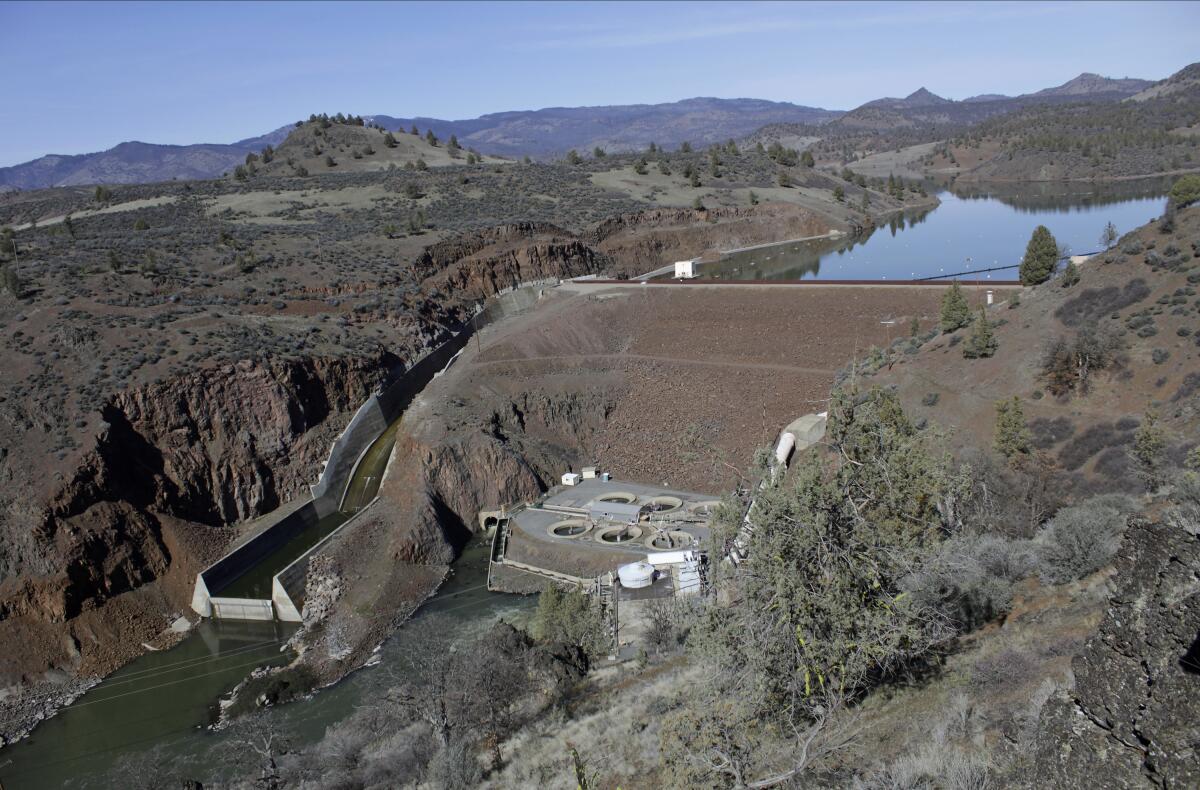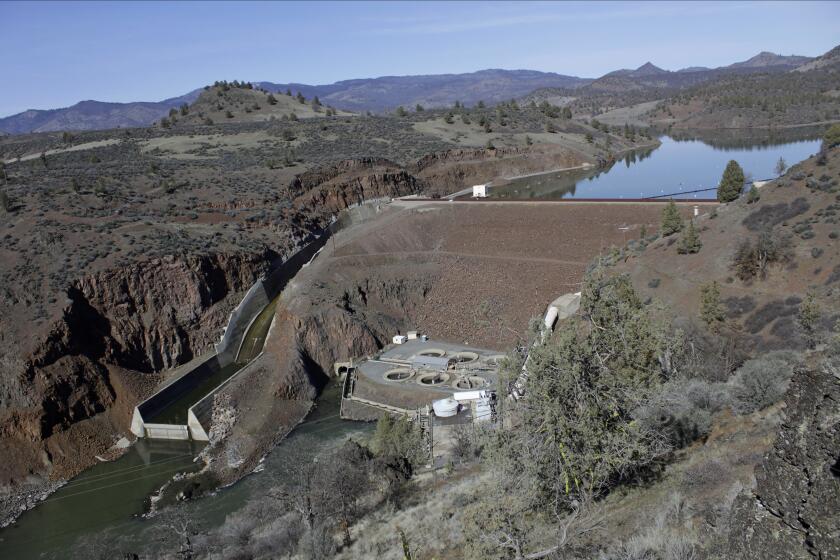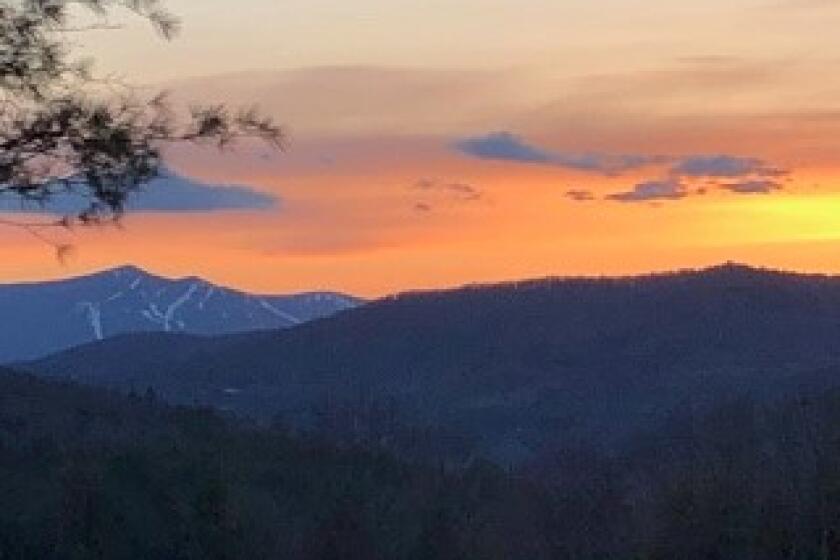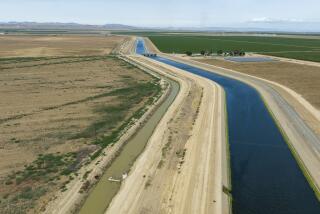Op-Ed: An epic victory in the battle for free-flowing rivers

- Share via
Two decades ago, when the Klamath River basin was considered the most embattled watershed in the country, the idea of removing the river’s four hydroelectric dams was considered laughable.
Yet on Thursday, the Federal Energy Regulatory Commission gave final approval to taking down the dams, setting in motion what will become the nation’s — and probably world’s — largest dam removal and salmon restoration project. The approval is a harbinger, a welcome turn from outmoded 20th century technology — hydroelectric dams — toward long-neglected natural processes, in the form of a free-flowing river.
The decision delivers a monumental victory to the basin’s Native American tribes whose cultures revolve around fish and have suffered as salmon and sucker fish have dwindled and, in the case of some species, disappeared. In concert with mainstream environmental groups, commercial fishers, scientists, lawyers and sympathetic government officials, the tribes presided over a 20-year campaign that overcame obstacle after obstacle and ended up underlining newfound tribal power.
“The Klamath salmon are coming home,” said Joseph James, Yurok tribal chairman, in a statement. The Yurok played a leading role in the long effort to, in James’ words, protect “the fish that have sustained our people since the beginning of time.”
Federal regulators have approved a plan to demolish four Klamath River dams, a historic act that is intended to save imperiled salmon.
Removal of the dams, whose combined height is 411 feet, will open up more than 400 river miles of spawning habitat. The salmons’ extended reach will promote genetic diversity, helping to fortify them against the accelerating threat of climate change. The dams’ reservoirs will no longer be cauldrons of highly toxic blue-green algae each summer, and salmon will be spared from river water overheated in the reservoirs by as much as 9 degrees Fahrenheit.
When the debate over the dams began, the basin was divided into two factions that loathed one another — pro-dam farmers and ranchers on one side, anti-dam tribal members and commercial fishers on the other. The George W. Bush administration supported the farmers, most notably by overriding the Endangered Species Act during a 2002 drought so they would receive water at the expense of salmon. That led to the die-off of some 78,000 adult salmon, according to Yurok estimates. It was the biggest fish kill in the history of the American West.
PacifiCorp, the Pacific Northwest utility that owned the dams, scorned removal. At one point, it cold-heartedly informed its Upper Basin customers that upkeep on the dams meant farmers’ electricity rates would increase 17-fold. That led many of them to reconsider their opposition to removal. Farmers and tribal members began talking to each other, first informally, then in intense, two-year-long negotiations.
Idaho’s Mike Simpson has a big idea that could help end decades of salmon wars in the Columbia River basin.
Tribal activists also mounted attention-garnering protests, including at annual meetings of Scottish Power, the energy conglomerate that owned PacifiCorp, in Edinburgh and Glasgow, Scotland. When Scottish Power rid itself of the problem by selling PacifiCorp to Berkshire Hathaway, Warren Buffett’s giant holding company, the activists moved their protests to that company’s annual meetings in Omaha.
Fortunately for the activists, the four dams, built between 1918 and 1962 and increasingly obsolescent, were up for relicensing in 2006. FERC ruled that to win 50-year renewals, PacifiCorp would have to install fish ladders on the dams. Adding the ladders, it turned out, would cost more than tearing down the dams. That eventually moved PacifiCorp to reconsider relicensing.
All this, coupled with courageous actions by numerous basin residents who forged a path toward reconciliation, led to two stunning deals announced in 2010. In the Klamath Basin Restoration Agreement, farmers consented to take less water from the river in return for guaranteed minimum amounts, while tribes reduced their demands for river flows as long as enough water remained to give salmon a reasonable chance of survival. And in return for payments from California taxpayers that covered part of the cost, PacifiCorp agreed to dam removal.
We’re at the beginning of the California diaspora, and we shudder at the thought.
The catch was that the agreements required congressional approval, and the then-ascendant tea party, which reflexively disapproved of dam removals, blocked the deals. It’s a painful irony that despite the tea party’s efforts, the one part of the 2010 agreements that survived is dam removal, which will now proceed, but without specific river restoration plans in place and without guaranteed water for farmers that the scuttled provisions included.
In fact, many farmers, most of them descendants of World War I and II veterans who acquired their land in government drawings, now feel left behind without the water guarantees. Intense drought has plagued the basin most years since 2014, with devastating consequences for agriculture. Water is so scarce that this year, two Upper Basin wildlife refuges that are key stopovers for migratory birds on the Pacific flyway were bone-dry. If dam removal fosters fish recovery, more water may be available for farmers and the refuges.
FERC’s approval has confirmed the tribes’ burnished standing and increased prospects that Native Americans will be heeded in natural resources disputes. Equally significant, the removal of large dams may now become more common. Said Craig Tucker, a Karuk tribe consultant and veteran dam removal campaigner, “If in five years fish are swimming and spawning 50 miles upstream from the dam sites and the river is cleaner and the fish are healthier, it’s going to convince people that this works.”
Jacques Leslie is a contributing writer to Opinion and the author of “Deep Water: The Epic Struggle Over Dams, Displaced People, and the Environment.”
More to Read
A cure for the common opinion
Get thought-provoking perspectives with our weekly newsletter.
You may occasionally receive promotional content from the Los Angeles Times.













